

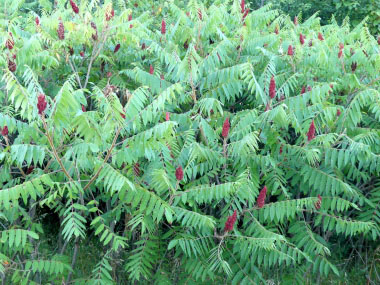
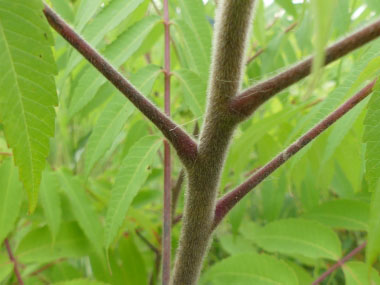

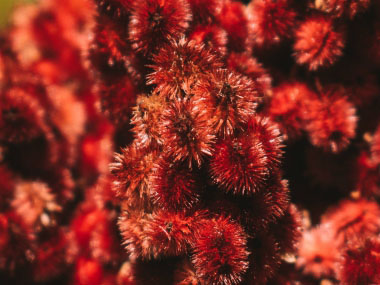
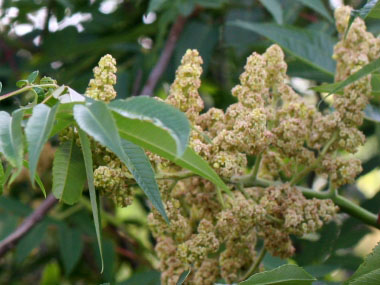
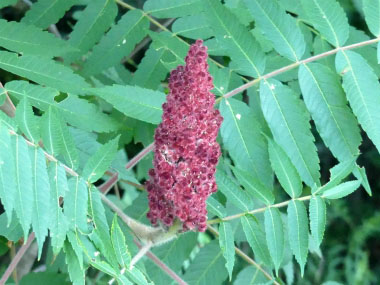
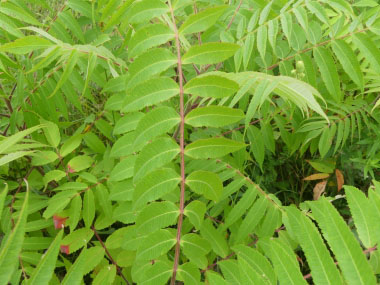
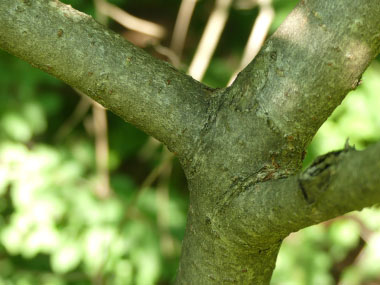
To support our efforts please browse our store (books with medicinal info, etc.).
One of the easiest deciduous shrubs to identify throughout the year, especially mid to late summer, staghorn sumac is in the anacardiaceae (cashew) family. Although technically a shrub, it can grow to a tree size. Staghorn sumac is native to the eastern parts of Canada and the U.S. By late summer it has beautiful autumn-coloured foliage and the fruit is a brilliant crimson red. Poison sumac (Toxicodendron vernix) has leaves somewhat similar to staghorn sumac. However, the big difference is that the poison sumac has clusters of grayish white berries that hang down, and it tends to grow exclusively in low, wet, or flooded areas such as swamps. The large clustered seed pods attract a variety of wildlife into the winter months.
Trunk/Bark
The trunks are generally between 5 and 10 cm (2 to 4”) wide, but some have been recorded with diameters as great at 38 cm (15”). Bark is typically smooth and dark brown. Bark on older wood is smooth and grey to brown.
Branches/Twigs
Staghorn sumac gets its name from its thick, velvety upper branches, which resemble the antlers of young male deer. Younger branches tend to be brown and smooth. Branches display U-shaped leaf scars in winter.
Height
Staghorn sumac grows in an open form that can grow up to 7 metres (25') tall and can be as equally wide.
Leaves/Needles
Staghorn sumac has alternate, compound leaves, 40 to 60 cm (16 to 24") long. Leaflets are narrowed or rounded at the base and sharply pointed at the tip with finely serrated edges. The leaflets are dark green and smooth above, and pale beneath, except along the midrib.
Flowers
Compact clusters of greenish-yellow flowers bloom from June to July. Individual panicles of flowers can get to about up to 30 cm (1') long and 15 cm (1/2') across. (Although on average they are about half that.) Each flower is about 5mm (1/4") across, consisting of 5 spreading petals, a calyx with 5 lobes, 5 stamens, and a central pistil.
Fruit
Staghorn sumac fruits mature from August to September. The fruiting head is a compact cluster of round, red, hairy fruits called drupes. Each drupe measures about 5mm (1/4”) in diameter and contains one seed. Each cluster of drupes can contain anywhere from 100 to 700 seeds. Only shrubs that are 3 to 4 years old can produce the fruit.
Habitat
This shrub is found throughout the eastern half of the U.S., Canada, as well as in parts of Europe and Asia. It generally prefers fertile, upland sites but tolerates a wide variety of conditions. It can grow in slightly acid soil but will not do as well as those in fertile areas. Typical habitats include open fields, roadsides, fence rows, and parkland.
Edible Parts
The ripe fruit can be used in baking but the tiny black seeds are very hard and can be problematic for the teeth if chewed on. The fruit has a citrusy yet sour flavour that is best enjoyed as a beverage.
Other Name
Rhus Typhina.
Recipes
Winter Survival Food Handbook

PDF Plant Magazines
Types of Wild Food
Geographic Zones Seasons
Disclaimer
EdibleWildFood.com is informational in nature. While we strive to be 100% accurate, it is solely up to the reader to ensure proper plant identification. Some wild plants are poisonous or can have serious adverse health effects.
We are not health professionals, medical doctors, nor are we nutritionists. It is up to the reader to verify nutritional information and health benefits with qualified professionals for all edible plants listed in this web site. Please click here for more information.
Why Edible Wild Food?
- Food costs are rising
- Free, wild food is readily abundant
- Wild food adds nutrition to your diet
- Wild food can help treat various medical conditions





